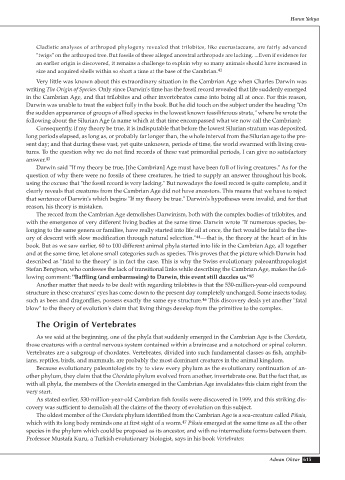Page 617 - Atlas of Creation Volume 2
P. 617
Harun Yahya
Cladistic analyses of arthropod phylogeny revealed that trilobites, like eucrustaceans, are fairly advanced
"twigs" on the arthropod tree. But fossils of these alleged ancestral arthropods are lacking. ...Even if evidence for
an earlier origin is discovered, it remains a challenge to explain why so many animals should have increased in
size and acquired shells within so short a time at the base of the Cambrian. 42
Very little was known about this extraordinary situation in the Cambrian Age when Charles Darwin was
writing The Origin of Species. Only since Darwin's time has the fossil record revealed that life suddenly emerged
in the Cambrian Age, and that trilobites and other invertebrates came into being all at once. For this reason,
Darwin was unable to treat the subject fully in the book. But he did touch on the subject under the heading "On
the sudden appearance of groups of allied species in the lowest known fossiliferous strata," where he wrote the
following about the Silurian Age (a name which at that time encompassed what we now call the Cambrian):
Consequently, if my theory be true, it is indisputable that before the lowest Silurian stratum was deposited,
long periods elapsed, as long as, or probably far longer than, the whole interval from the Silurian age to the pre-
sent day; and that during these vast, yet quite unknown, periods of time, the world swarmed with living crea-
tures. To the question why we do not find records of these vast primordial periods, I can give no satisfactory
answer. 43
Darwin said "If my theory be true, [the Cambrian] Age must have been full of living creatures." As for the
question of why there were no fossils of these creatures, he tried to supply an answer throughout his book,
using the excuse that "the fossil record is very lacking." But nowadays the fossil record is quite complete, and it
clearly reveals that creatures from the Cambrian Age did not have ancestors. This means that we have to reject
that sentence of Darwin's which begins "If my theory be true." Darwin's hypotheses were invalid, and for that
reason, his theory is mistaken.
The record from the Cambrian Age demolishes Darwinism, both with the complex bodies of trilobites, and
with the emergence of very different living bodies at the same time. Darwin wrote "If numerous species, be-
longing to the same genera or families, have really started into life all at once, the fact would be fatal to the the-
44
ory of descent with slow modification through natural selection." —that is, the theory at the heart of in his
book. But as we saw earlier, 60 to 100 different animal phyla started into life in the Cambrian Age, all together
and at the same time, let alone small categories such as species. This proves that the picture which Darwin had
described as "fatal to the theory" is in fact the case. This is why the Swiss evolutionary paleoanthropologist
Stefan Bengtson, who confesses the lack of transitional links while describing the Cambrian Age, makes the fol-
lowing comment: "Baffling (and embarrassing) to Darwin, this event still dazzles us." 45
Another matter that needs to be dealt with regarding trilobites is that the 530-million-year-old compound
structure in these creatures' eyes has come down to the present day completely unchanged. Some insects today,
such as bees and dragonflies, possess exactly the same eye structure. 46 This discovery deals yet another "fatal
blow" to the theory of evolution's claim that living things develop from the primitive to the complex.
The Origin of Vertebrates
As we said at the beginning, one of the phyla that suddenly emerged in the Cambrian Age is the Chordata,
those creatures with a central nervous system contained within a braincase and a notochord or spinal column.
Vertebrates are a subgroup of chordates. Vertebrates, divided into such fundamental classes as fish, amphib-
ians, reptiles, birds, and mammals, are probably the most dominant creatures in the animal kingdom.
Because evolutionary paleontologists try to view every phylum as the evolutionary continuation of an-
other phylum, they claim that the Chordata phylum evolved from another, invertebrate one. But the fact that, as
with all phyla, the members of the Chordata emerged in the Cambrian Age invalidates this claim right from the
very start.
As stated earlier, 530-million-year-old Cambrian fish fossils were discovered in 1999, and this striking dis-
covery was sufficient to demolish all the claims of the theory of evolution on this subject.
The oldest member of the Chordata phylum identified from the Cambrian Age is a sea-creature called Pikaia,
47
which with its long body reminds one at first sight of a worm. Pikaia emerged at the same time as all the other
species in the phylum which could be proposed as its ancestor, and with no intermediate forms between them.
Professor Mustafa Kuru, a Turkish evolutionary biologist, says in his book Vertebrates:
Adnan Oktar 615

